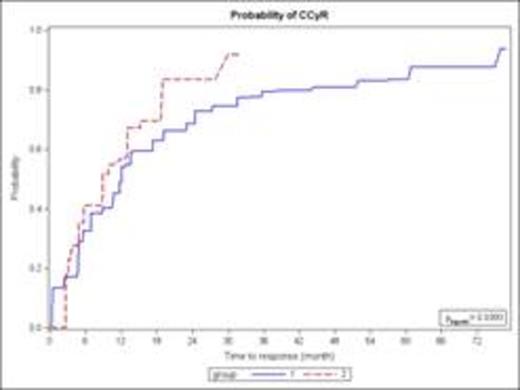Abstract
Introduction: Most surrogate endpoints are based on periodical measurement and the assessment of event time uses data censored by both sides. Kaplan-Maier (KM) estimators are calculated from right censored data and as result they are biased and sensitive to irregularity in measurements. High rate of missing data and irregularity is a common problem for registries. Interval Censorship Estimators (ICE) are relative complex but more reliable and robust than KM. Cytogenetic response is a major prognostic factor for long-term results of therapy of chronic myeloid leukemia (CML) and is often used as surrogate endpoint. The challenge of ICE usage instead of KM’s for cytogenetic response estimation is illustrated on real data from the registry of patients with CML.
Methods and data source: We compare data in 2 studies of similar population of CML patients. The studies are distinguished by the design and completeness of data. First one is retrospective, second is prospective controlled registry population study. For evaluation of time to event characteristics two estimators were used and compared: classical KM estimators and ICE estimators based on Turnbul’s algorithm, realized as SAS Macro [1]. The EUropean Treatment Outcome Study (EUTOS) is a registry based international investigation started in June 2007 running for 3 years. The aim is to study the epidemiology of CML. The first part of the study is OUT Study section (EUTOS-OSP) with retrospectively collect data form patients who are not included into the local or international clinical trials. The second part of EUTOS study is online registry so called Population Based Sections (PBS EUTOS) aimed to estimate incidence of CML in EUROPE.
Results: For the analysis we made 2 data sets. First one includes data of 508 patients with 2005-2008 years of diagnosis from study EUTOS-OSP collected retrospectively from 36 regions of Russian. Median age at diagnosis was 49,3 years, range from 18 to 82, 47,6% of men, 6.7% in AC,BC phase, 29,3% at high risk by Sokal. Second set includes data of all 200 patients of PBS EUTOS study prospectively collected form 6 regions of Russia in 2008-2012 years. Median age at diagnosis was 50,4 years, range from 16 to 82, 50,8% of men, 6.0% in AC,BC phase, 31,7% at high risk by Sokal. Progression free survival (PFS) and complete cytogenetic responds (CCyR) probability were calculated by traditional KM method in OSP and PBS data sets. Also ICE estimations of the CCyR was done in this data sets. The 3-year PFS was estimated as 89.6% in OSP set and 88.8% in PBS set (fig. 1). KM estimations gives median time to CCyR =17.5 months in OSP and 12 months in PBS group, delta=5.5 moths (fig.2), if ICE estimations is used median time to CCyR =12 month in OSP, 8.5 month in PBS group, delta=3.5 moths (fig.3). The difference of CCyR between OSP and PBS was much less on fig.3 than on fig.2. The completeness of cytogenetic data in both studies was quite distinguishing. Percentages of patients with reported cytogenetic tests were following: in 6±3 month – 333/497 (67%) in OSP and 151/174 (87%) in PBS, in 24±3 month – 254/470 (54%) in OSP and 52/79 (66%) in PBS.
KM estimations of CCyR in OSP (dash line) and PBS (solid line) sets.
ICE estimations of CCyR in OSP (dash line) and PBS (solid line) sets.
Long term results of studies are almost identical (p=0.3, fig.1) although the KM estimations of response rates are essentially different (p<0.001, fig.2). Difference in CCyR estimations almost disappear (p=0.04,fig 4) if more robust ICE technique is used. So illusion of difference in CCyR is caused by completeness of data and not by the clinical reasons.
Conclusions: Irregularity of time assessment of surrogate endpoints and missing data may lead to bias of classical estimations and then to wrong interpretations. The challenge of ICE usage instead of KM is illustrated on real data from CML registries. ICE estimations showed to be reliable and robust in comparison to classic right censored estimations.
1. References: So Y., Johnston G. Kim S.H.: // Analyzing Interval-Censored Survival Data with SAS® Software. SAS Global Forum 2010.
No relevant conflicts of interest to declare.
Author notes
Asterisk with author names denotes non-ASH members.




